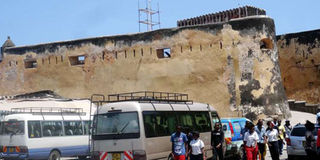Fort Jesus monument's world heritage status at risk over graffiti

Local tourists leave Fort Jesus after a tour on February 20, 2015. PHOTO | LABAN WALLOGA | NATION MEDIA GROUP
What you need to know:
- The Fort Jesus curator also singled out insecurity, travel warnings and global warming as some of the challenges facing the huge symbolic representation of Mombasa.
- Others are low number of visits and negative culture.
- But despite the challenges, the monument recently added another feather to its cap by winning this year’s Trip Advisor Award.
Graffiti may erode the world heritage status of the Fort Jesus monument in Mombasa County, experts have warned.
National Museums of Kenya (NMK) Senior Curator Sadu Rashid said visiting couples scribble their names on the walls of the monument, defacing the finely crafted ancient buildings.
“Graffiti is one of the major challenges we are facing. It is mostly done by couples and university students who visit the place and we are looking into how we will stop it to avoid further damage on these walls,” she said during the Fourth Annual Curators Meeting (ANCUM) in Meru Town.
She said Fort Jesus holds an archive of human prehistory and asked those practising their handiwork on the buildings to stop.
The Fort Jesus curator also singled out insecurity, travel warnings and global warming as some of the challenges facing one of the biggest symbolic representations of Mombasa.
Others are a low number of visits and negative culture.
ENSURE SURVIVAL
The curator noted that communities living around cultural and heritage sites should be involved in developing management plans for the sites to ensure their survival.
“We are working with the police to improve security around the building especially where muggings and robbery have been reported. I’m also asking the residents to participate in community policing,” she said.
But despite the challenges, the monument recently added another feather to its cap by winning this year’s Trip Advisor Award.
“We also got funds from Unesco to do a study of the extent of sea erosion, which is threatening the stability of Fort Jesus,” she said, adding that they are working with the Mombasa County government to do more exhibitions that will promote the site.
Gedi Ruins curator Ali Mwarora said poaching posed a great risk to the endangered and indigenous animals living in the nearby forest.
“Poachers are using snares to capture Guegon monkeys, elephant shrews and bushbucks. However, we are working with an animal rights lobby group who do de-snaring on a weekly basis,” Mr Mwarora said.
Gedi Ruins in Kilifi County thrived between the 12th and 18th centuries, before its inhabitants mysteriously deserted it, leaving it to decay.
SACRED SITE
It is managed by the NMK and is sacred for traditional rituals and sacrifices.
The NMK's director in charge of museums, sites and monuments, Ms Purity Kiura, told counties to repackage their services and products to maximise on benefits that give tourism circuits a unique identity.
She said most products that could boost revenue from tourism were drawn from the culture of the people and natural sites.
Dr Kiura said many counties are within regions rich in cultural diversity and captivating sites.
The official added that counties are expected to build local museums that encourage the preservation of traditional sacred sites as places of ecological, cultural and spiritual importance.
ANCUM was started in 2011 to address the declining state of conservation and research as well as to disseminate new information on the museums, sites and monuments.




